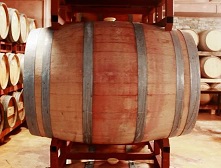Wine Characteristics
 Aperitif
Wine
Aperitif
Wine
One meant to be served before a meal as an appetizer.
Blanc de Blancs
White wine made from white grapes; this French
phrase usually refers to sparkling wine made from fine Chardonnay grapes. A few
table wines also carry this name.
Brut
Dry or lacking sweetness, used in reference to sparkling
wines. This is the driest type of champagne normally sold; see also "extra dry."
Dessert Wine
A term formerly used to indicate sweet wines,
such as sherries, ports, and muscatels, that are fortified with brandy to bring
them up to an alcohol content of around 16 to 18 percent. (See "fortified.") Now,
the meaning is more precise: a wine to be served with desserts or by itself after
a meal. Dessert wines today include such sweet wines as Muscat Canelli and "late
harvest" White Riesling, which have alcohol contents as low as just 10 to 12 1/2
percent.
Dry Wine
One lacking sweetness, with most or all of its sugar
converted into alcohol by fermentation. Most table wines are dry to fairly dry--to
complement the flavors of most foods prior to the dessert course.
Extra Dry Wine
Term used on a label to indicate that a sparkling
wine is slightly sweet (contradictory but true!). See also "brut" and "sec."
Flavored Wine
"Pop" wines are often flavored with citrus
or other fruit. Vermouth is flavored with herbs and spices. Only natural flavors
may be added to wine under Federal regulations.
Fortified
Wine in which fermentation was stopped and the
alcohol content increased by the addition of grape brandy. This process is used
for sherries, ports, and other wines whose alcohol content reaches 16 to 18 percent--sometimes
even more in very sweet wines.
Generic
In the United States, our generic wines borrow European
names which have specific meanings in their own countries but not here. Examples
include burgundy, Chablis, Rhine wine, and sauterne. Many wineries are phasing out
such labels in favor of more descriptive and accurate names (see "varietal"). However,
it's likely that burgundy (for an inexpensive red wine) and Chablis (for an inexpensive
white) will be in use in America for quite some time.
Late Harvest
A wine made from grapes picked after their juices
are extra sweet and concentrated (see "Botrytis").
Proprietary
One carrying a name originated by a specific
winery - essentially a brand name. Examples include Paul Masson's "Emerald Dry,"
Gallo's "Tryolia," and Christian Brothers' "Chateau LaSalle."
Sec
A French word meaning "dry"; however, when applied to
champagne it has come to indicate a medium sweet one (see "extra dry").
Still Wine
Any non-sparkling wine.
Table Wine
Red, white, or pink wines of 11 to 13 percent
alcohol, suitable for serving with food.
Varietal
Term used to indicate that a wine is made predominantly
of the grape variety named on the label. For example, Zinfandel wine is supposed
to be made from Zinfandel grapes. A new Federal law now specifies that a minimum
of 75 percent of a varietal wine be made from the grape listed on the label.
Vintage Wine
Wine from a single year named on the label,
rather than a blend from several years. Vintage wines are necessarily good; there
are fine years, average years, and poor years for most wines.
Air Fryer ~ American Regional ~ Appetizers ~ Baby Food ~ Back of the Box ~ Beans ~ Beverages ~ Bowls/Buddha Bowls ~ Bread ~ Breakfast/Brunch ~ Camping/Hiking ~ Candy ~ Canning ~ Casseroles ~ Celebrity ~ Condiments ~ Cookies ~ Cooking for a Crowd ~ Cooking for Two ~ Cowboy/Ranch ~ Crock Pot ~ Dessert ~ Diet ~ Energy Bars ~ Family Favorites ~ Fish/Seafood ~ Gifts in a Jar ~ Grill ~ Holidays ~ Home Remedies ~ Instant Pot ~ International ~ Jiffy Mixes ~ LuAnn's Family Favorites ~ Meat ~ Meatless ~ Mixes ~ Name Brand ~ Nutella ~ Packet Cooking ~ Pampered Chef ~ Pasta/Rice/Beans ~ Pet Food ~ Picnic ~ Pizza ~ Potluck ~ Pressure Cooker ~ Restaurant ~ Salads/Salad Dressings ~ Sandwiches ~ Sauces ~ School Cafeteria ~ Seasoning/Flavored Oil/Vinegar ~ Sheet Pan ~ Side Dishes/Veggies ~ Snacks ~ Soup/Stew/Chili ~ Spreads ~ State Fair ~ Syrup ~ Tofu ~ TVP ~ Two-Ingredients ~ Vegetarian ~ Wild Game
Articles ~ Cooks Corner ~ Glossary (Dictionary) ~ Household Hints ~ Kitchen Hints

